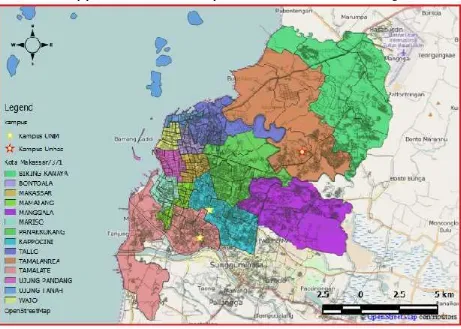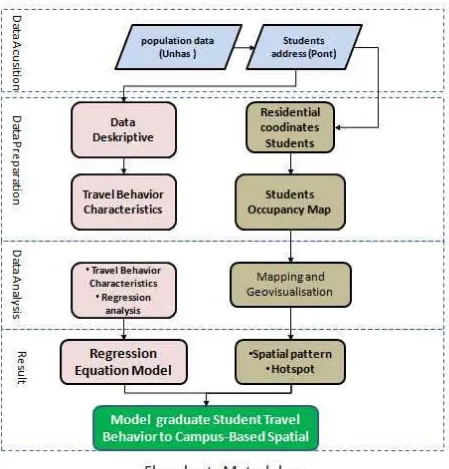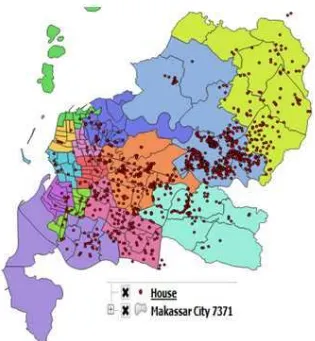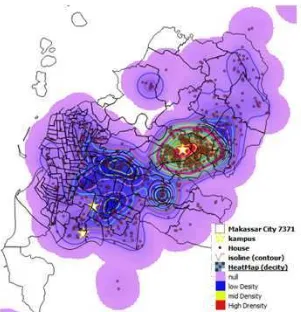TRAVEL BEHAVIOR OF STUDENTS TO CAMPUS BASED SPATIAL
Travel behavior to campus is the primary journey that has a large enough proportion of the trip, especially in Makassar that affect the performance of roads around campus. Travel behavior to campus is influenced by socio-economic variables and spatial variables. This study aims to: 1) To Analyzing the characteristics of the travel behavior of students to campus at public universities in Makassar; 2) Analyzing the regression model of residence location choice based socio-economic factors and spatial factors; 3) To analyze the spatial patterns of residential location of the college students in Makassar, in terms of geographical distribution and identify hotspots.Metode used method of regression and spatial location of the shelter anlisa students at the University of Hasanuddin Makassar. Regression analysis showed a significant association between living costs of students with the direct distance between the campus and residential location. The other thing is a significant relationship between the cost of transport to the Distance trip to campus. Furthermore, spatial analysis methods Hotspot and isolines for student residential location.
INTRODUCTION
Education is one of the basic human needs. In fulfillment of the need for education, especially formal education, then there was movement toward campus. The movement itself requires a mode of transport as a means to move. The phenomenon of the campus environment as an area with all forms of activity in it. Campus as an educational area will result in seizure and pull the trip. Travel is not limited to movement from one place to another, but in campus activities not only one type of activity being done. But the journey that followed occurred mobility other activities that should be done. Mode of transportation to work as a supporting mobility traveling.
Modal choice varies for each individual student. This variation can be attributed to a number of factors such as culture and different behaviors, different effects on trips based on environmental conditions, topography and geography, the influence of the availability of various modes of transport, nature jan network and road network conditions and government policies. Selection of a mode of transportation for a trip to campus is one example of regular travel behavior, because students generally travel to campus at around the same relative time each day, with the same intensity (following the lectures), and passes through the same route habit of traveling to campus is one of the most important predictor for routine travel behavior. Thus the habit very important factor in explaining the behavior of students using the mode of transportation to campus. According Tumlin (2004), one of the most effective ways that minimize travel costs and distance, Sertan to reduce transport needs is to provide shelter for the perpetrators be traveling at a location travel destination
ways ascribing continuous variable data to given areal units that are predefined. In practice, however, none is unproblematic. Mapping and geovisualisation is an important step to provoke questions, but exploratory data analysis requires highly interactive, dynamic data displays. Recent developments in spatial data analysis software provide an interactive environment that combines maps with statistical graphs, using the technology of dynamically linked windows.
The phenomenon of interest may be described in most general terms as interactions between populations of actors and opportunities distributed over some relevant geographic space. Such interactions may involve movements of individuals from one location to another, such as daily traffic flows in which case the relevant actors are individuals such as commuters (shoppers) and the relevant opportunities are their destinations such as jobs (or stores). Similarly, one may consider migration flows, in which case the relevant actors are migrants (individuals, family units, firms) and the relevant opportunities are their possible new locations.( Manfred M.)
According Mark P. The core of transportation are access to activity sites. This means that the population establishes proximity to places of work, recreation, socializing, shopping, and school. In transportation planning, individual passenger trips are often classified by the purpose of the trip and the trip origin. Common home based trip types include:
• Work Trips. Trips made to a person's place of employment such as a factory, a
store, or an office.
• Shopping Trips. Trips made to retail establishment regardless of the size or type of
purchase. Trips made to a store "just to look" are shopping trips even though no purchase is made.
• Social or recreational trips. Cultural trips made to recreational or entertainment
facilities ( e.g., church, civic meetings, concerts, sporting events). Travel to social activities ( parties, visiting friends) would be included.
• Business Trips. Trips made in the course of performing a normal day's work. The
origin of such trips is often the place of employment.
• School Trips. Trips made by the students to an institution of learning.
Research Purposes
The purpose of this study are :
• To Analyzing the characteristics of travel behavior of students to campus at public
universities in Makassar.
• Analyzing the regression model residence location choice based socio-economic
factors and spatial factors.
• To analyze the spatial patterns of residential location of the college students in Makassar, in terms of geographical distribution and identify hotspots.
LITERATURE REVIEW
number of students who study at the campus resulted in the increasingly congested roads and students who go to and from college many who use personal automobiles, motorcycles and public transport, it accounts for density and traffic congestion on the roads around the University of Hasanuddin and the State University of Makassar. Therefore, the need for proper planning to resolve transportation problems that occur around the Hasanuddin University and State University of Makassar.
The existence of domestic college campus in the city of Makassar affect the amount of traffic generation and attraction. It is often congestion during peak hours in the morning, afternoon and evening. It is caused by:
1. The number of public transport passengers in the front of the lower ascending campus.
2. The high number of pedestrian crossing on the road around the campus without the necessary bridge for pedestrian crossings.
3. The number of vehicles that enter and exit the campus. 4. Less optimal functioning traffic light around campus.
5. geometric condition of roads around campus is not adequate to accommodate the
volume of traffic.
• Spatial analysis
GIS (Geographic Information System) is a powerful tool that allows to perform spatial analysis and graphic representation of large amounts of data. Analysis of demand for transport and transport planning is a process of intensive data processing. Understanding the needs of the transport depends on the analysis of travel behavior, which in turn depends on several factors among which are the socio-demographic characteristics, the characteristics of land use and transport system itself. This paper explores how GIS can be used to analyze a sample that represents the population of spatial data and temporal data varied.
Demand for transport are usually derived from the demand for primary travel activities. Understanding how spatial environmental impact in the choice of activities is very important to understand the travel behavior and associated impacts such as congestion and decrease air quality from vehicle emissions due to the increase in the volume of vehicle traffic. In addition, consideration of the factors in the socio-economic analysis of transportation demand allows institutions in the field of transport related to not only predict the future needs of the transportation demand, but also allows them to adjust programs and policies to affect the entire system changes such as the shift mode or increase the use of public transport .. There are two main levels of transportation needs analysis; namely 1) the method of aggregate and disaggregate method. Disaggregate analysis done using data collected at the individual level - the choices made on the mode used, participation activity, time of departure, vehicle ownership, income, residential location, school or workplace and several other variables. This data can be collected to understand the travel patterns of areas as small as urban level to the regional level is greater, for example. option for individuals to travel depending on the options available to them, such as the lack of public transit lines operating or transit stop in an area will deter and reduce the mobility. The program enables GIS spatial analysis and mapping to present visually from land use and transport infrastructure and identify potential markets or transport facilities and infrastructure gaps.
• Spatial Data
from other data, the location information (spatial) and descriptive information (attributes) that is described as follows
Opera-locations (spatial), associated with a good coordinates geographic
coordinates (latitude and longitude) and the XYZ coordinates, including datum and projection information.
Descriptive information (attributes) or nonspasial information, a location that has some information related to it. Examples of types of vegetation, population, area, zip code and so on.
• Measuring travel distance
One of the most important parameters in measuring the spatial accessibility is the distance between the supply and the demand locations. Various measures of distance ranging from Euclidian distance to travel times can be identified in the literature. In their study on the accessibility to health services in Montreal, Apparicio et al. (2008) found a correlation of .992 between the shortest network distance and the shortest time distance.. Following this work, we selected the shortest network distance as our distance parameter (Travel-time should be used if distance is a poor measure of travel impedance e.g. if roads are unevenly distributed and travel speeds vary to great extent.
Regression Analysis.
Regression analysis is one of the analysis of the most popular and widely used. Regression analysis is widely used to make predictions and forecasts. This analysis is also used to understand any independent variables associated with the dependent variable, and to determine the forms of the relationship. Regression is composed of one independent variable (predictor) and the dependent variable (Response / Criterion) is called simple linear regression (bivariate regression), while the independent variable regression over a so-called multiple regression (Multiple regression / multivariate regression), which may consist of the two predictors (multiple regression) or more
• Analisis Regresi Sederhana dan Regresi Berganda.
Simple Regression Analysis and Regression.
Regression analysis was used to determine whether a variable can be used to predict or forecast the other variables, if a dependent variable (the dependent variable) depend on the independent variable (independent variable), the relationship between the two variables is called a simple regression analysis.
Multiple Linear Regression Analysis. In a statistical regression analysis is one method to determine the causal relationship between one variable with another variable. variabelY called independent variables, or variables, variable X (as is often depicted in the graph as abscissa, or X axis). These variables are known as variable that is affected, the dependent variable, dependent variable, or variable Y. Both of these variables can be a random variable (random), but the variable that is affected must always be random variables
Common forms of simple linear regression equation showing the relationship between the two variables: the variable X as independent variable and variable Y as the dependent
variable is :
which showed that: Yi = dependent variable Independent variables X1 =
a = intercept (the dot is cut curve on the Y axis) b = The slope of linear curve
RESEARCH METHODOLOGY
• Research Location.
The location study performed at the University of Hasanuddin in Makassar as in Figure 1
Figure 1: Map Location Research
• Methodology.
RESULTS AND DISCUSSION
• Regression Analysis
From the results of the analysis by the method of regression linear regression model between the dependent variable (Y) is the allowance and the independent variable (X) sort path with R2 values of 0:52. These results indicate that the cost allowance will be increased along with the increase in short path, as well as the relationship between student transportation costs will increase with distance Travel with R2 value of 0.64. Regression model are presented in Table 1 below.
• Spatial analysis
Based on survey data Hasanuddin University students using the GPS device can be mapped locations such as a student residence in Figure 2 below :
Figure 2: Map of location of residence Students
Figure 3: Figure 3: Map of the density of location of residence Students (Hotspot)
Student residential locations can also be analyzed mapped with map isolines (contour) as figure 4 below
CONCLUSION
From the results of the regression equation, found a significant association between living costs of students with the selection of the location of residence. The greater the distance between campuses with student residential location, then the greater the student living costs. Likewise, the cost of transport on the way to the campus there is a significant relationship with the travel distance. The greater the distance of travel, then the greater the transportation costs.
In this study also, it was found that the students concentrated on the residential locations around campus as shown on the map Hotspot. It is closely related to the level of accessibility and transportation costs and living expenses of students.
In order to make decisions in the field of transport and education, we need to have more detailed information about the characteristics of student travel and transportation facilities and infrastructure information. This method can provide a new perspective is needed for education policy makers to do with transportation planning, decision-makers and local authorities. With the help of GIS can assist transportation planners in analyzing and taking the right policy.
BIBLIOGRAPHY
Jacob Larsen (2011). A Travel Behavior Analisys Of Urban Cycling Facilities In Montreal Canada. Transportation Research Part D: Transport andEnvironment, 16 (2), 172-177. Nakarin Chaikaew (2009). Exploring spatial patterns and hotspots of diarrhea in Chiang Mai, Thailand. International Journal of Health Geographics.
Mark P. De Guszman(2005).Analysis of Mode Choice Behavior Of Student In Exclusive School in Metro Manila: The Case of Ateneo De Manila University & Miriam Collage. Proceedings of the Eastern Asia Society for Transportation Studies, Vol. 5, pp. 1116 -1131, 2005
Setiawan, R.(2014) Integration of Theory of Planned Behavior and Norm Activation
Model on Student Behavior Model Using Cars for Traveling to Campus. Civil
Engineering Dimension, Vol. 16, No. 2
McNally, Michael G (1997).The Potential for Integrating GIS in Activity-Based Forecasting Models. Department of Civil & Environmental Engineering and Institute of Transportation Studies, University of California, Irvine; Irvine.
Rohan P Fisher(2012).Free and simple GIS as appropriate for health mapping in a low resource setting: a case study in eastern Indonesia. International Journal of Health Geographics 2011



